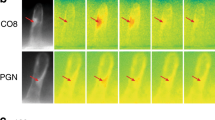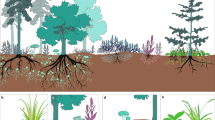Abstract
The molecular mechanisms underlying mycorrhizal symbioses, the most ubiquitous and impactful mutualistic plant–microbial interaction in nature, are largely unknown. Through genetic mapping, resequencing and molecular validation, we demonstrate that a G-type lectin receptor-like kinase (lecRLK) mediates the symbiotic interaction between Populus and the ectomycorrhizal fungus Laccaria bicolor. This finding uncovers an important molecular step in the establishment of symbiotic plant–fungal associations and provides a molecular target for engineering beneficial mycorrhizal relationships.
This is a preview of subscription content, access via your institution
Access options
Access Nature and 54 other Nature Portfolio journals
Get Nature+, our best-value online-access subscription
$29.99 / 30 days
cancel any time
Subscribe to this journal
Receive 12 digital issues and online access to articles
$119.00 per year
only $9.92 per issue
Buy this article
- Purchase on Springer Link
- Instant access to full article PDF
Prices may be subject to local taxes which are calculated during checkout


Similar content being viewed by others
Data availability
Data that support the findings of this study have been deposited in public repositories. The transcriptomics data have been deposited by the Joint Genome Institute at GenBank (http://www.ncbi.nlm.nih.gov/genbank/) under the accession code SRP117109.
References
Whitham, T. G. et al. Science 320, 492–495 (2008).
Vozzo, J. A. & Hacskaylo, E. Bull. Torre. Bot. Club 101, 182–186 (1974).
Gottel, N. R. et al. Appl. Environ. Microbiol. 77, 5934–5944 (2011).
Tuskan, G. A. et al. Science 313, 1596–1604 (2006).
Martin, F. et al. Nature 452, 88–92 (2008).
Martin, F., Kohler, A., Murat, C., Veneault-Fourrey, C. & Hibbett, D. S. Nat. Genet. 47, 410–415 (2015).
Kohler, A. et al. Nat. Genet. 47, 410–415 (2015).
Tagu, D. et al. Mycorrhiza 10, 237–240 (2001).
Labbé, J. et al. Tree Genet. Genomes 7, 617–627 (2011).
Geraldes, A. et al. Mol. Ecol. Resour. 13, 306–323 (2013).
Muchero, W., Labbé, J., Ranjan, P., DiFazio, S. & Tuskan, G. A. in Challenges and Opportunities for the World’s Forests in the 21st Century Vol. 81 (ed. Fenning, T.) 587–595 (Springer Netherlands, 2014).
Slavov, G. T. et al. New Phytol. 196, 713–725 (2012).
Evans, L. M. et al. Nat. Genet. 46, 1089–1096 (2014).
Muchero, W. et al. BMC Genom. 16, 24 (2015).
Plett, J. M. et al. New Phytol. 202, 270–286 (2014).
Tschaplinski, T. J. et al. Mol. Plant Microbe Interact. 27, 546–556 (2014).
Vaid, N., Macovei, A. & Tuteja, N. Mol. Plant 6, 1405–1418 (2013).
Singh, P. & Zimmerli, L. Front. Plant Sci. 4, 124 (2013).
Müller, A., Volmer, K., Mishra-Knyrim, M. & Polle, A. Front. Plant Sci. 4, 332 (2013).
Hacquard, S. et al. Nat. Commun. 7, 11362 (2016).
Felten, J. et al. Plant Physiol. 151, 1991–2005 (2009).
Plett, J. M. et al. Curr. Biol. 21, 1197–1203 (2011).
Wu, Y. & Zhou, J. M. J. Integr. Plant Biol. 55, 1271–1286 (2013).
Antolín-Llovera, M. et al. New Phytol. 204, 791–802 (2014).
Ranf, S. et al. Nat. Immunol. 16, 426–433 (2015).
Kumar, S., Nei, M., Dudley, J. & Tamura, K. Brief. Bioinform. 9, 299–306 (2008).
Van Ooijen, J. & Kyazma, B. MapQTL 6 (Kyazma BV, 2009).
Kosambi, D. D. Ann. Eugen. 12, 172–175 (1943).
Nakagawa, T. et al. Plant Biotechnol. 26, 275–284 (2009).
Acknowledgements
We thank M. Kirst at the University of Florida for allowing us to use the P. deltoides population. This work was supported by the Plant-Microbe Interfaces Scientific Focus Area in the Genomic Science Program, the Office of Biological and Environmental Research in the US Department of Energy (DOE) Office of Science. The transcriptomics work was supported by the BioEnergy Science Center (BESC) and the Center for Bioenergy Innovation (CBI). BESC and CBI are US DOE Bioenergy Research Centers supported by the Office of Biological and Environmental Research in the DOE Office of Science. Oak Ridge National Laboratory is managed by UT-Battelle, LLC., for the US DOE under contract No. DE-AC05-00OR22725. The work conducted by the US DOE Joint Genome Institute was supported by the Office of Science of the US DOE under contract No. DE-AC02-05CH11231. W.M. was supported in part by the DOE Office of Science Early Career Research Program under the Biological and Environmental Research programme office. J.L. and F.L.T. were supported in part by a visiting grant from the Laboratory of Excellence ARBRE (No. ANR-11-LABX-0002-01) and the Region Lorraine Research Council. K.Z., J.W., X.W. and H.W. were partially supported by visiting scholarships from the China Scholarship Council. Part of the work was performed at the Oak Ridge Leadership Computing Facility at the Oak Ridge National Laboratory. The views expressed in this article do not necessarily represent the views of the US Department of Energy or the US government.
Author information
Authors and Affiliations
Contributions
J.L., W.M., J.-G.C. and G.A.T. initiated the project and coordinated data analysis and manuscript preparation. J.L., W.M., J.W., O.C. and T.L. analysed the QTLs and performed genotyping. O.C., X.W., A.C.B., K.Z., Y.Y., M.X., D.W., P.M., H.W., J.L.M.-F., K.R.C., L.G.S.M., J.-M.A., R.M., S.S.J. and J.-G.C. performed Arabidopsis-related experiments. Z.Z., T.J.T. and D.A.J. performed metabolite profiling. W.S., J.M. and J.S. analysed the Populus resequencing data. L.E.G. and F.L.T. assisted with QTLs and plant–fungal experiments. J.Z., T.L., P.R., E.L., X.Y. and K.B. performed transcriptomics analysis. J.L., W.M., J.-G.C. and G.A.T. drafted the manuscript and all authors critically reviewed and approved the final version of the manuscript for publication.
Corresponding author
Ethics declarations
Competing interests
The strategy for genetic engineering of host–microbe symbiosis into non-host organisms based on the discovery described in this paper has been included in a patent application filed by UT-Battelle, LLC.
Additional information
Peer review information: Nature Plants thanks Mika Tarkka and the other, anonymous, reviewer(s) for their contribution to the peer review of this work.
Publisher’s note: Springer Nature remains neutral with regard to jurisdictional claims in published maps and institutional affiliations.
Supplementary information
Supplementary Information
Supplementary Methods, Supplementary References, Supplementary Figs. 1–8 and Supplementary Tables 1–3.
Rights and permissions
About this article
Cite this article
Labbé, J., Muchero, W., Czarnecki, O. et al. Mediation of plant–mycorrhizal interaction by a lectin receptor-like kinase. Nat. Plants 5, 676–680 (2019). https://doi.org/10.1038/s41477-019-0469-x
Received:
Accepted:
Published:
Issue Date:
DOI: https://doi.org/10.1038/s41477-019-0469-x
This article is cited by
-
Cell wall integrity regulation across plant species
Plant Molecular Biology (2022)
-
Rice pollen aperture formation is regulated by the interplay between OsINP1 and OsDAF1
Nature Plants (2020)
-
Alterations in the phenylpropanoid pathway affect poplar ability for ectomycorrhizal colonisation and susceptibility to root-knot nematodes
Mycorrhiza (2020)



